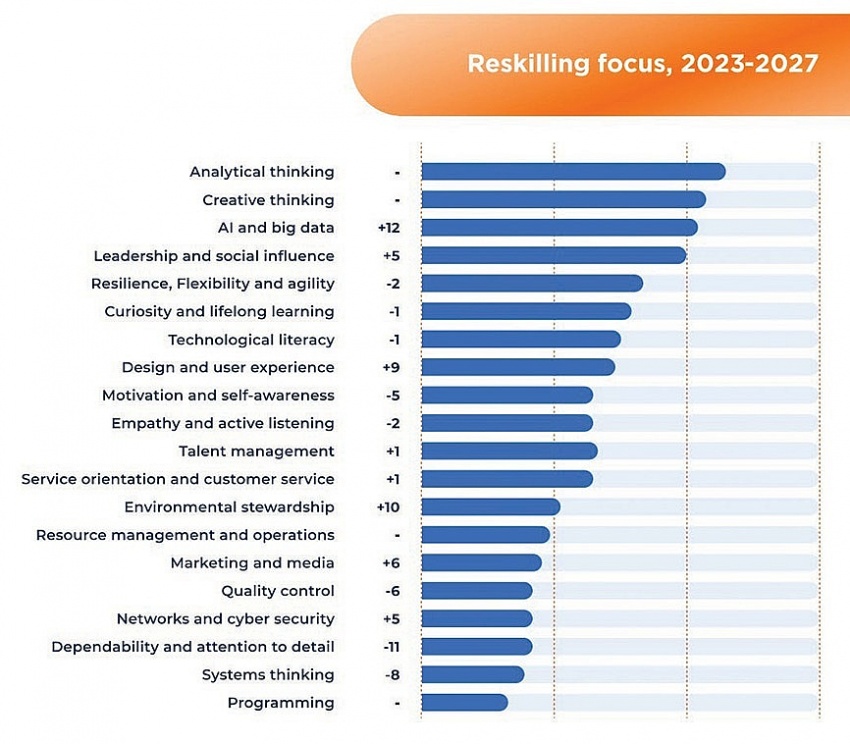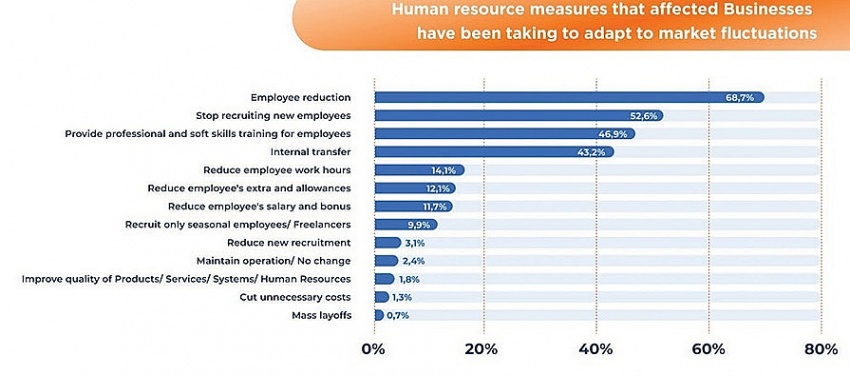Businesses urged to adapt with reskilling opportunities
At a conference in early January on tasks for 2024, Dao Ngoc Dung, Minister of Labour, Invalids, and Social Affairs (MoLISA) emphasised that the labour industry would accelerate this year.
“The goal is to continue to maintain the unemployment rate below 4 per cent, and increase the rate of trained workers to 69 per cent and workers with certificates and degrees to 28 per cent,” Minister Dung said.
By the end of last year, Vietnam had about 52.4 million workers, of which trained workers accounted for two-thirds and workers with diplomas and certificates held 27 per cent.
However, there are still more than one million unemployed workers and more than 900,000 individuals of working age who are underemployed, more than 40 per cent of whom are young people, according to the General Statistics Office.
Although worried that complicated developments in the economy will continue to put pressure on the labour market this year, recent positive signs have led the MoLISA to believe that job opportunities may be gradually returning.
The Department of Labour, Invalids, and Social Affairs of Ho Chi Minh City forecasts that the city needs about 300,000-320,000 more workers in 2024. Many manufacturing and service businesses in the city have started large-scale recruitment campaigns since the beginning of January, including businesses that cut thousands of workers a few months ago.
Worldon Viet Co., Ltd. needs to recruit 8,000 workers, for example, while AEON Vietnam is looking to recruit about 3,000 employees. Lotte Vietnam needs to recruit 1,000 seasonal employees, while Southeast Vietnam Co., Ltd. is to recruit more than 500 workers. Big textile groups also want to take on hundreds of new workers.
 |
| Source: Source: Navigos Group |
Choppy waters
In Hanoi, the recruitment needs of businesses may reach 100,000 individuals in the first quarter, focusing on manufacturing, e-commerce, and tourism, according to the Hanoi Employment Service Centre.
Do Duc Tri, deputy general director of Nhan Kiet Supplying ManPower Co., Ltd., said that it needs to recruit thousands of unskilled workers to work in industrial zones in the provinces of Bac Ninh, and Bac Giang, and Hanoi.
“The demand for labour recruitment is increasing by 20-30 per cent, focusing on electronics and manufacturing. Many foreign-invested enterprises in such zones are facing a serious shortage of human resources,” Tri said.
Contrary to positive assessment from Vietnamese management agencies, research by independent consulting units and international organisations has made fewer positive judgments about the employment market, at least until the end of 2024.
According to the International Labour Organization’s (ILO) World Employment and Social Outlook: Trends 2024 report published on January 10, joblessness and the jobs gap have both fallen below pre-pandemic levels, but global unemployment will rise this year, and growing inequalities and stagnant productivity are causes for concern.
“In 2024, an extra two million workers are expected to be looking for jobs, raising the global unemployment rate from 5.1 per cent in 2023 to 5.2 per cent,” the report said.
The ILO report adds that important differences persist between higher and lower income countries. While the jobs gap rate in 2023 was 8.2 per cent in high-income countries, it stood at 20.5 per cent in the low-income group. Likewise, while the 2023 unemployment rate persisted at 4.5 per cent in high-income countries, it was 5.7 per cent in low-income countries.
“It is starting to look as if these imbalances are not simply part of pandemic recovery but structural,” said ILO director-general Gilbert Houngbo. “The workforce challenges it detects pose a threat to both individual livelihoods and businesses, and it is essential that we tackle them effectively and fast.”
According to Navigos Group Talent Guide: Salary & Labour Market Report 2024, the labour situation in Vietnam faces many difficulties. According to the survey results, up to 82.2 per cent responded that they were affected by market fluctuations in 2023. For businesses affected by market fluctuations in 2023, the most chosen solution is employee reduction (68.7 per cent).
Navigos’ report noted that despite fluctuations in the recruitment market, nearly 60 per cent of Vietnamese businesses said they will still recruit 25 per cent more employees in 2024.
 |
| Source: Source: Navigos Group |
Adapting to change
Along with fluctuations in job opportunities, the labour market is also differentiated due to changes in work needs and new prospects.
Navigos said that flexible working was the trend that most workers were interested in. The company predicts that new jobs that will gradually appear in Vietnam will focus on AI, digital technology, data processing, and business analysis, mostly appearing in IT, telecommunications, construction, real estate, banking, education, financial services, consulting services, and insurance.
To be well-prepared when the market economic situation stabilises and develops again, employees need to grasp new employment trends, and know how to apply AI to work to create competitive advantage in an increasingly demanding recruitment market, said Ryosuke Kanemoto, CEO of Navigos Group.
“Not only in Vietnam, but businesses and employees around the world are currently trying to undertake many solutions to cope with economic fluctuations, make changes in thinking, business operation, necessary skills, recruitment and job search activities,” Kanemoto added.
ManpowerGroup Vietnam’s 2024 salary guide also informs that the demand for green jobs and green skills in recent years has increased significantly. About 70 per cent of businesses globally have been actively recruiting for positions requiring green skills.
It advises that businesses cannot satisfy the diverse needs and desires of workers based only on salary but need to offer more flexible solutions to engage and retain them.
Meanwhile, CEO of Viet Research Truong Minh Tien said that the challenges of the job market will continue this year, large-scale cuts were expected to continue, but demand for labour recruitment would continue to grow 4-5 per cent each year.
“Fluctuations in the job market did not only depend on employers, instead, workers also had the right to proactively choose,” Tien said. “The most important reasons affecting employees’ decisions to stay or leave their jobs are welfare and income, career development opportunities, corporate environment and culture, company reputation and work-life balance.”
 | Get started on reskilling workforce The digital age has been creating big changes in the labour market and in each business. Researchers have forecast that many of today’s jobs may disappear within the next few years. However, new jobs requiring new skills are appearing. The question is, how can organisations meet the human capital demands of the present and the future? |
 | Future of manufacturing: Up- and re-skilling during a tech revolution New roles and new skills are born and rise to primacy while others are being replacedby the global digital transformation. Le Thi Kim, head of Staffing and Outsourcing Services, North, ManpowerGroup Vietnam writes about up-skilling and re-skilling at manufacturing businesses to confront the challenges by the Fourth Industrial Revolution. |
What the stars mean:
★ Poor ★ ★ Promising ★★★ Good ★★★★ Very good ★★★★★ Exceptional
Related Contents
Latest News
More News
- Businesses ramp up production as year-end orders surge (December 30, 2025 | 10:05)
- Vietjet chairwoman awarded Labour Hero title (December 29, 2025 | 13:06)
- How to unlock ESG value through green innovation (December 29, 2025 | 10:03)
- AI reshapes media and advertising industry (December 29, 2025 | 08:33)
- FPT and GELEX sign deal to develop blockchain tech for global markets (December 29, 2025 | 08:29)
- Vietnam’s GDP forecast to grow by 9 per cent in 2026 (December 29, 2025 | 08:29)
- Women entrepreneurs are key to Vietnam’s economic growth (December 29, 2025 | 08:00)
- Vietnam's top 500 value-creating enterprises announced (December 27, 2025 | 08:00)
- The PAN Group shaping a better future with ESG strategy (December 26, 2025 | 09:00)
- Masan Consumer officially lists on HSX, marking the next phase of value creation (December 25, 2025 | 13:20)

 Tag:
Tag:





















 Mobile Version
Mobile Version